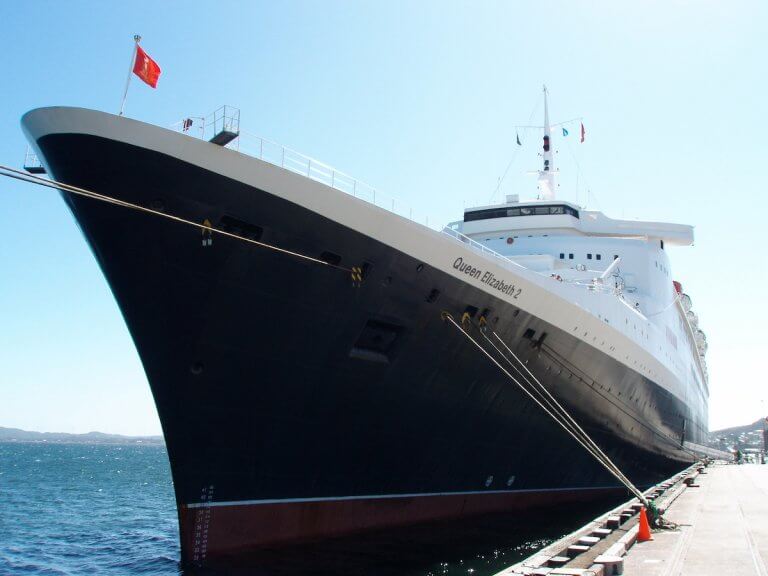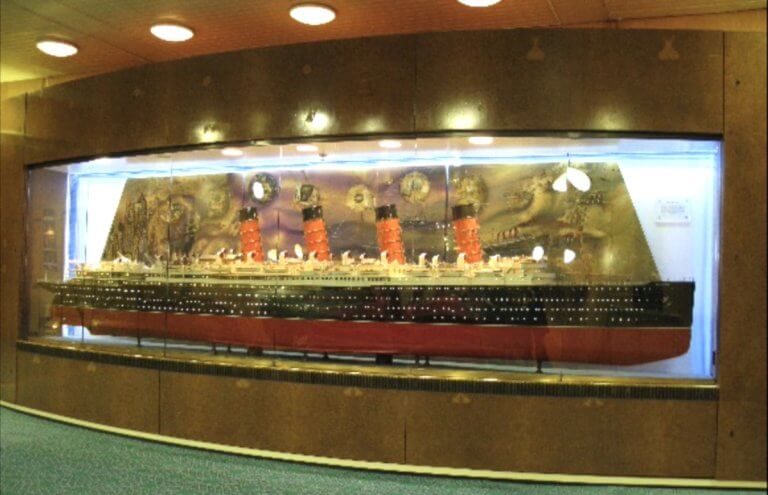
I have been an Interpretive Planner for museums around the world for over 30 years. When I started in 1992, the term was rarely used. Family and friends still ask: “What is it exactly that you do?” So I thought I would look back over my 30 years in museums, zoos, aquaria and heritage sites to pick out some of the favourite exhibits that I have worked on as a way of explaining the process of interpretive planning and what it is. Here we look at the QE2 Heritage Trail.
As part of the MET Studio team that worked on 1994 refit of the QE2 called Project Lifestyle, I was lucky enough to work as the researcher who effectively helped put together a floating museum on probably the most famous ocean liner in the world.
An American travel writer, Lynn Weldon, at the time wrote a very evocative piece in praise of the QE2 Heritage Trail (also known as the Cunard Heritage Trail) which is hard to beat:
“If the Queen Elizabeth 2 is a floating history museum, then the Cunard Heritage Trail is its premier gallery. Those who enjoy the romantic history of cruise travel and the long legacy of Cunard will find the Heritage Trail is reason enough to book passage on the QE2 for the first (or fifteenth) time.
In his 150th anniversary book Cunard: 150 Glorious Years, John Maxtone-Graham said, “For a century and a half, the name Cunard has conjured up vivid images…the quickest, the most civilized way to cross the Atlantic, the greatest liners of the world, luxury shipboard in all its guises.” Now, Cunard has the perfect place for many of these vivid images.
The Heritage Trail was an integral addition to the $45 million refurbishment of the legendary QE2. It depicts the history and legend of Cunard, the QE2, and transatlantic cruise travel in perhaps the most appropriate setting possible. Where better to explore the long lineage of Cunard and cruise travel than aboard one of the most historic ships still afloat?
The Heritage Trail consists of a large series of museum-standard displays established in strategic areas throughout Cunard’s flagship. Passengers can pick up a leaflet guide to the trail from the front desk or they can join one of the frequent guided tours scheduled during every cruise. Many floating history buffs opt for both methods, as well as chance encounters with the Trail throughout the ship.
“The Trail is a testament to the pride with which the Cunard Line regards traditions and the distinguished history of the company,” says Thomas Quinones, the QE2’s cruise director and occasional Trail tour guide. Passengers will find genuine historic material dating back to the company’s origins in 1840, including ship models, nautical instruments, marine paintings, Cunard Line posters, photography, memorabilia, and special commemorative items.
On July 4, 1840, the wooden-hulled paddle steamer Britannia set out from Liverpool for Halifax, Nova Scotia, and Boston. With Cunard founder Samuel Cunard aboard, this marked the beginning of regular steamship service carrying mail and passengers across the Atlantic. The Cunard Line would eventually grow to own or manage more than 200 ships.
From small beginnings, the Cunard Line grew rapidly. Sailings from 1850 onwards were mainly to New York and ships soon became larger, faster, and with more modern amenities. Cunard ships featured many firsts, such as the China being driven by propeller rather than paddles and the Servia offering electric lighting. Ships like the Umbria and Etruria offered food refrigeration, a vast improvement over the ship’s cow that produced milk for Britannia passengers.

With the success of the Lusitania, Mauretania, and Aquitania in the early-1900s, the Cunard passenger lists evolved into a star-studded saga of royalty, statesmen, industrialists, and actors or actresses. The Queen Mary and Queen Elizabeth further enhanced Cunard’s cruise travel legacy, while the QE2, Royal Viking Sun, Vistfjord, Sea Goddess I, and Sea Goddess II continue to do so today.
Thanks to the Heritage Trail, all of this history comes alive for all passengers to see. There’s seemingly a new discovery around every elegant corner of the endless burr oak veneer.
The Ocean Liner Museum Collection serves as a perfect introduction to the depth of the Trail. The New York-based museum provided two display cases full of Cunard publications dating back to the turn of the century, including promotional materials, menus, schedules, souvenirs, passenger lists, and much more. Similarly, the Peter Radmore Collection contains more fascinating memorabilia. Radmore held one of the largest collections of Cunard material until his death in 1992.
The round Midships Lobby is ringed by four large black-and-white panels that depict key eras in the history of the Cunard Line. As part of Cunard’s long tradition of commissioning decorative works from some of the best artists of the day, British artist Peter Sutton prepared these panels for the 1994 refurbishment.
A graphic trip down (or up) memory lane can be taken at “E” stairway, where a company art deco poster gallery conveys Cundards images during the first half of the 20th century. Other stairway art and artifacts include a marine art gallery (historic and current Cunard vessels), stunning QE2 launch tapestries, and the Royal Portraits collection, which were originally exhibited on the Queen Elizabeth and Caronia respectively.

Further visual history can be found at the Worldwide Family display. Ocean Pictures, official photographers for all of Cunard’s passenger ships since 1929, provided hundreds of interesting images depicting Cunard cruising at its finest. Those who look closely will find the likes of Jacqueline Onassis, Elizabeth Taylor, Rita Hayworth, Richard Burton, Pearl Bailey, and many members of royalty.
The QE2’s social director, Elaine Mackay, relates a story that perfectly relates the lure of the Trail. With a broad smile, she says, “In the Midships Lobby, I was explaining all of the panels when I pointed out a bellboy on the Queen Mary. A man in the group said, ‘You’re not going to believe this, but that bellboy was me.’ He had been a bellboy in his teens and even showed me a picture he carried with him on the QE2. It really made the inanimate mural come to life.” The entire Cunard Heritage Trail can have that effect on anyone wishing to step back into history with Samuel Cunard and his fabled cruise line.”
I remember distinctly the many happy hours spent at Ocean Pictures (who had had the rights to take official photos on board for decades) browing through boxes of original old photographs and negatives to select those to go on display.
A rare video shows some of the interiors after this refit 30 years ago including part of the Cunard Heritage Trail such as the giant Mauretania model.
The QE2 now acts as a floating hotel docked at Port Rashid in Dubai.
